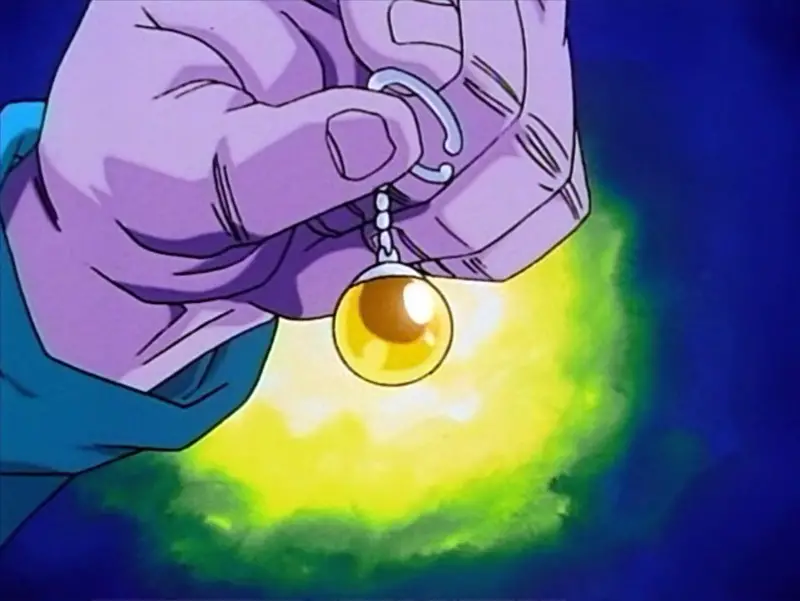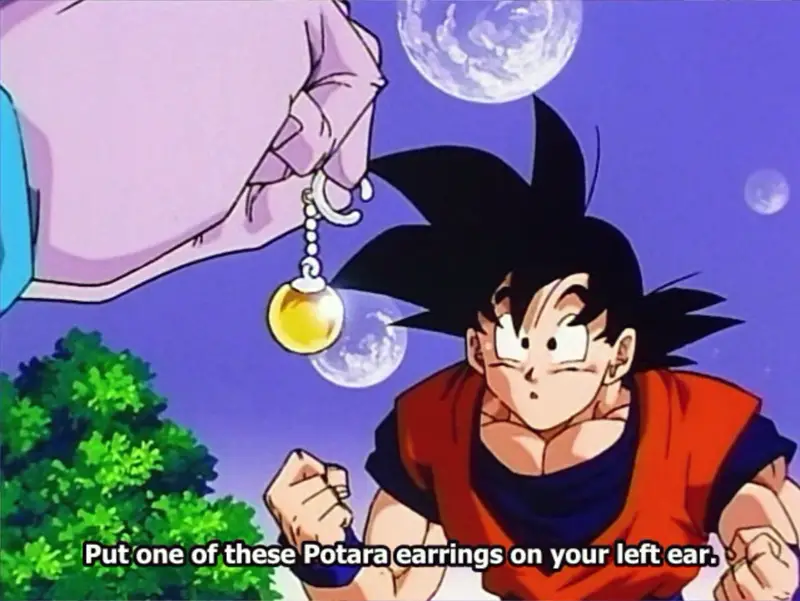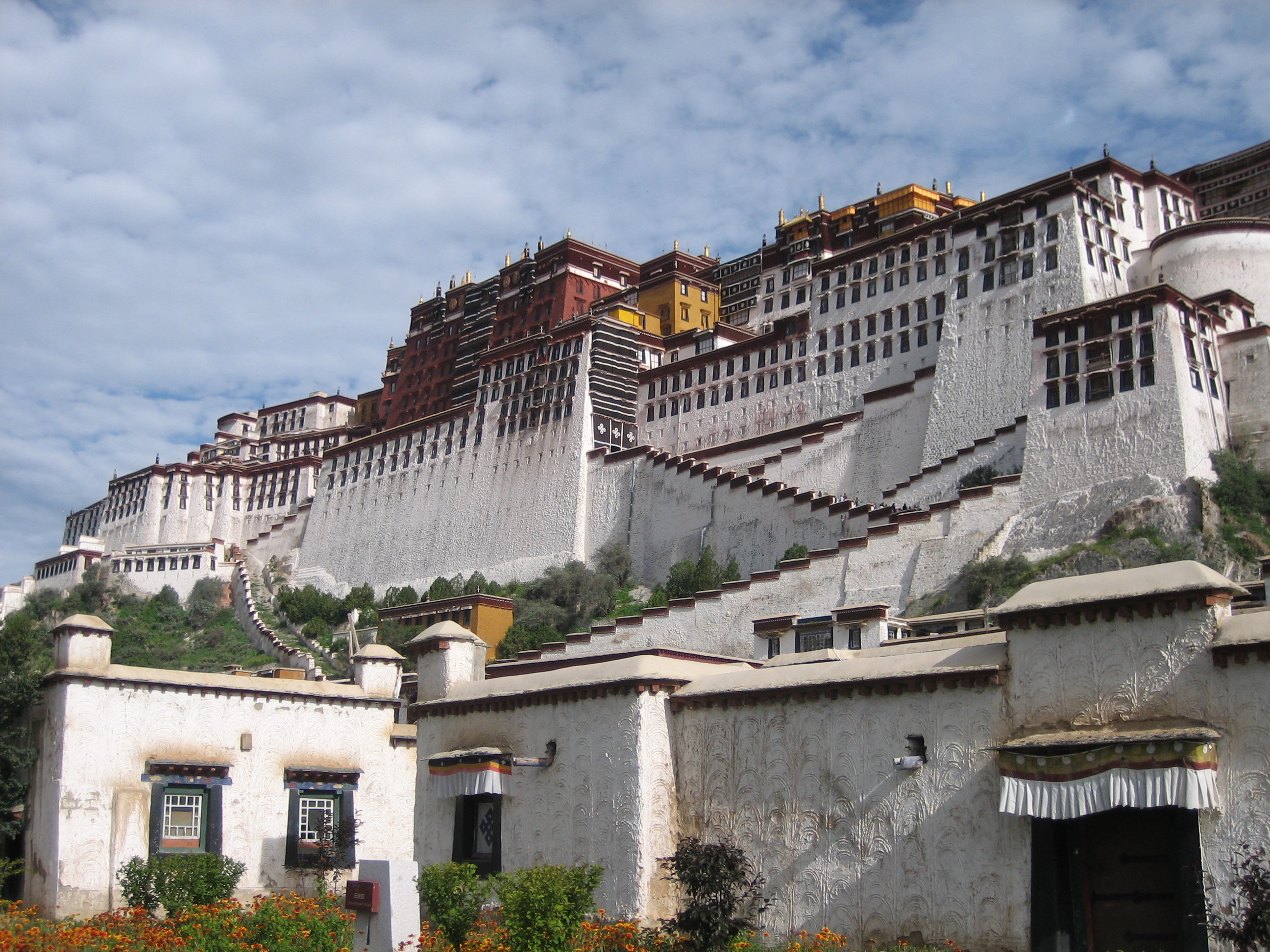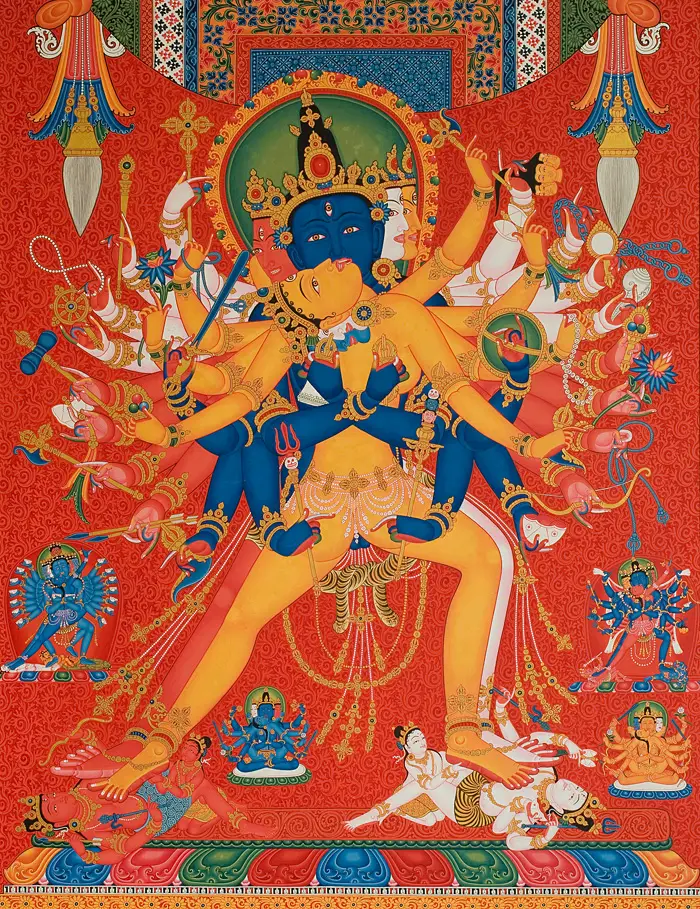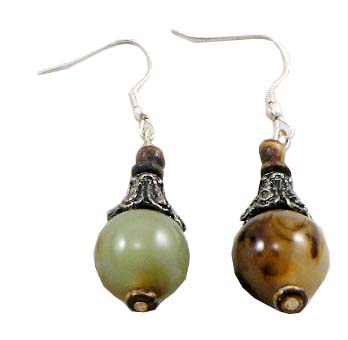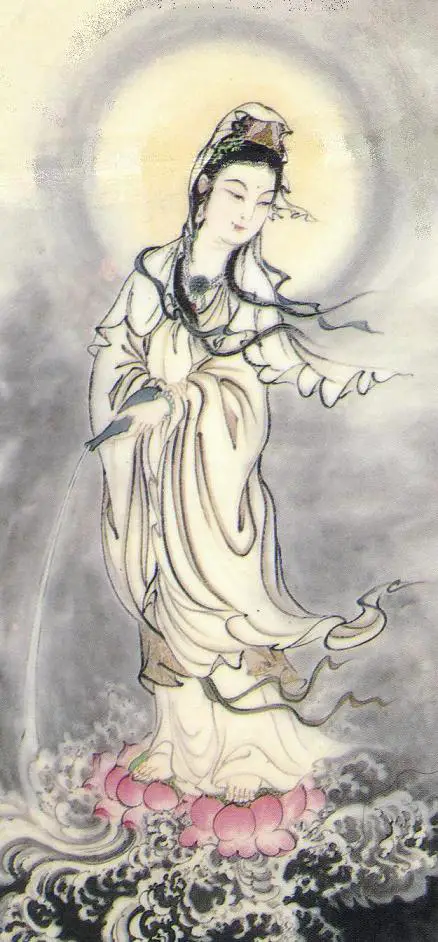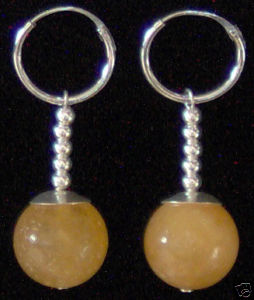Potara, Potala, Potaraka
The Potara earrings are a device in Dragon Ball Z introduced near the end of the Majin Buu Saga. They allow one character to fuse together with another and increase their power level dramatically.
Everybody knows and loves them. But is there more to these simple earrings than meets the eye?
When all hope seems lost, Goku is given a Potara earring by Eldar Kai (Japanese: Rou Dai Kaioshin) that allows him to fuse with another person. They look like spherical ball earrings suspended by silver beads attached to a hoop that is placed in the earlobe.
Goku convinces Vegeta to wear one of the earrings while Goku wears the other. Immediately they are drawn to one another and their two bodies slam together, creating a new superhuman warrior.
The pair combined has the best of Vegeta’s pride and Goku’s rage, creating Vegetto, self-named after the combination of Vegeta and Kakarotto (Goku’s birth given Saiyan name).
According to Kanzentai.com, in The Super Exciting Guide: Story Volume, “On p.63 it describes the Potara fusion as being closer to multiplication rather than simple addition in the way it increases power. Supposedly, Vegetto’s battle power is equivalent to Goku’s battle power multiplied by Vegeta’s. Also according to the introduction of the Super Exciting Guide’s training section, all the information in it is based on data that was supervised by Toriyama, though we have no idea how extensive this supervision was.”
This makes Vegetto the strongest character in the entire manga.
But where did Akira Toriyama come up with the idea of Potara? What’s the story behind them?
Toriyama’s Explanation
In Daizenshuu 6: Movies & TV Specials guide (December 9, 1995), Toriyama is asked about the Potara in an interview.
Interviewer: “Fusion” is another way to power up, right? How was that concept born?
Toriyama: That, I think, as a concept, came out of a discussion with Katsura-kun [Masakazu Katsura, a manga creator] that ‘There is nothing stronger than Super Saiya-jin.’ We usually just fool around with each other, and he jokingly said at the time, ‘In that case, maybe the only remaining way to become stronger is to fuse together.’ I replied, ‘Hey, that’s a great idea! You do say good things sometimes. This is the first time you’ve helped me.’ (laughter) That’s how that idea was born.
The interviewer then asks him how he came up with the concept of Potara.
Toriyama: Well, that was just because fusion was being used up in the movies, and I was thinking, ‘What should I do?’ Since I had been drawing earrings, I wondered, ‘Can I use these somehow?’
Interviewer: So, you didn’t draw the earrings as a way to fuse together from the beginning?
Toriyama: Nope. They were initially just decorations.
Interviewer: Then it was a product of the circumstances.
Toriyama: I’ve long been walking such dangerous fine lines (laughter). However, when I’m cornered, my brain waves seem to sharpen, and somehow ideas start to flow. In addition, I’m good at forceful finagling (laughter).
And that’s all Toriyama is recorded as saying about the Potara’s origins. So he was drawing earring designs and decided to use them in Dragon Ball. Perhaps it was as simple as that. Many of Toriyama’s explanations for things are surprisingly simple.
But where did the word Potara come from? Toriyama does not mention this specifically.
My theory is that Potara actually has a cultural and historical origin.
Potala Palace of Tibet
The most likely source of the word Potara in Dragon Ball stems from the Potala Palace in Lhasa, Tibet.
The now 13-story high Potala Palace in Lhasa was founded in 1645 AD. It served as the previous residence of many Dalai Lamas throughout history. It is the political seat of the Tibetan Government and house of the Gelug school of Tibetan Buddhism, also known as the “Yellow Hats.” The Gelug is the most politically powerful and well known of Tibetan Buddhist practices, and the Potala served as a Winter Palace for the Dalai Lama of that generation. In 1959 the Dalai Lama was forced to retreat from Tibet in response to the Chinese Communist Party’s assault. It has since been turned into a museum.
The Japanese refer to Potala as Potara. This is because in Japanese the R’s and L’s are often pronounced as opposites or both simultaneously, as a sort of R, L and D sound altogether. Other examples of this reversal in Dragon Ball include Shen Ron (instead of the Chinese Shen Long) and Porunga (instead of Polunga), the Divine Dragons that come out of the dragon balls.
Furthermore, the earrings designed by Toriyama are similar to a traditional Tibetan drop earring, which have a spherical shape embedded in a cap.
More than a Name – Dual Cultivation
But there’s more to this theory than just a single name.
Tibetan Buddhism is an esoteric (secret) practice of Buddhism that is taught behind closed doors. It involves many ritualistic experiences of the Tantric order. One of these is known as “dual cultivation of male and female.”
This is a practice of dual cultivation, meaning that more than one person’s body is used to refine a practitioner. It is a Tantric act where two bodies become one. The male partner will hold the female in physical union. The female partner chosen is one of utmost purity, and the entire act is overseen by a master monk to ensure that the two are able to maintain their virtue and follow the ritual accordingly.
The union brings together the highest qualities of each practitioner and sends the pair into a higher state of awareness. Their enlightenment to higher states allows both of them to reach a plane of ultimate bliss.
The artistic representations of these acts are often seen in Tibetan Thangkas (Scroll paintings). They depict different male gods in physical union with female consorts. They are paintings of dual cultivation that are symbolic of the duality of the Tibetan Dharma.
The male wraps the female with his arms and holds the Bell (Female aspect) in the left hand and the Dorje (aka Vajra) (Male aspect) in the right hand. The two elements together balance the positive and negative and bring one to enlightenment. The two people essentially become one person, and with more ‘power’ than the original, as they can enter a higher level of Heaven. It is considered a sacred practice and one is that not disclosed to a lay practitioner.
From a Daoist perspective they would say this type of practice is one where “The Yin supplements the Yang, and the Yang supplements the Yin.”
In Dragon Ball Z anime episode 268, Goku places the earring on his left ear and Vegeta places the earring on his right. The two beings are forcefully drawn toward one another. When their bodies make contact a huge explosion of light and energy erupts from that point. Their bodies and minds fuse together and form a new being with a higher state of awareness and incalculable power that is even stronger than the gods.
At this point they are neither Goku nor Vegeta. With the voice of two beings united as one he says, “I wondered what was going to happen, but it appears as if they successfully combined together. Now then, let’s continue!”
Potaraka Island and Guan Yin
It is also possible that Toriyama referenced Journey to the West for this name, as the book serves as the literary wellspring from which Dragon Ball came forth. This is because in Journey to the West there is a mystical location known as Potaraka Island.
In Chapter 22 of Journey to the West, Monkey, Pig and the Tang Monk Sanzang experience difficulty in capturing the Sand Demon who guards the sandy river. Despite their best efforts at defeating the monster they still need to ask for help from Bodhisattva Guan Yin (the Buddhist Saint of Compassion).
“‘If you’re going to ask the Bodhisattva to come,’ Sanzang said, ‘don’t waste a moment, and be back as quickly as possible.’
“Monkey then somersaulted off on his cloud towards the Southern Sea, and before an hour was up he saw Potaraka Island. An instant later he landed outside the Purple Bamboo Grove, where the twenty-four devas came forward to greet him with the words, ‘Why have you come, Great Sage?’
“‘Because my master is in trouble,’ Monkey replied, ‘I have come for an audience with the Bodhisattva.’ The deva on duty that day asked Monkey to sit down while he went in to report, whereupon he went into the Tide Cave to announce that Sun Wukong was seeking an audience on business. The Bodhisattva was leaning on a balcony looking at the blossoms in the Precious Lotus Pool with the Dragon Princess Peng Zhu when she heard the news. She went back in her cloudy majesty, opening the door and summoning Monkey to her presence. The Great Sage greeted her with grave reverence.”
Outside of Journey to the West, there is a “Little Potala Palace” (Chinese: Putuo Zongchengzhi Si) in Chengde City, China, that was constructed in 1771 of the Qing Dynasty. As the largest temple of the Eight Outer Temples, the Little Potala Palace was constructed to commemorate Emperor Qianlong’s birthday. It emulates the original Potala Palace’s design.
The Little Potala Palace is also known as the Temple of the Potaraka Doctrine, as it is a Mayahana Buddhist School that studies the Fa of Bodhisattva Guan Yin.
So there is a temple in Tibet and a temple in China. But no temple in Japan named Potala. This means Toriyama most likely borrowed the word from somewhere else.
Also noteworthy is that there is a Potara in India. The Potara Kund is located in the city of Mathura in the North Indian state of Uttar Pradesh. Kund is the Hindi word for “tiny lake.” Potara Kund is a stepped red sandstone artificial water tank in which Krishna’s baby clothes were believed to be washed. Krishna is the highest level deity worshipped in India, and the Potara Kund is mentioned in the Bhagavata Purana and also the Bhagavad Gita, a Vedic tale of war and theology that recounts Krishna’s childhood.
So it’s equally possible that Toriyama found this word while researching the Vedic texts.
Conclusion
It’s unknown where Toriyama came up with the word Potara. But it is probably from one of the above named sources. The concept of dual cultivation and unification is also intriguing.
Maybe Toriyama will state the source of his inspiration one day.
In either case, now you know a little bit more about the Potara earrings.
Resources:
- http://blog.t2world.com/2009/06/potala-palace.html
- http://en.wikipedia.org/wiki/Krishna
- http://www.chengdetour.com/chengde-attractions/templeofpotarakadoctrine.htm
- http://www.kanzentai.com/bp.php?id=guide
- http://monkeyking.lewisoft.net/MKW/en/journeytothewest_22.php
- http://www.tamashop.com/DragonballKaioshinPotaraEarrings.htm
- http://talesofwisdom.com/2009/07/09/an-allegory-of-cultivation-a-stubborn-water-bottle-2/
- http://www.toranahouse.com/BJthangkacat1.html
' . $comment->comment_content . '
'; } } else { echo 'No comments found.'; }